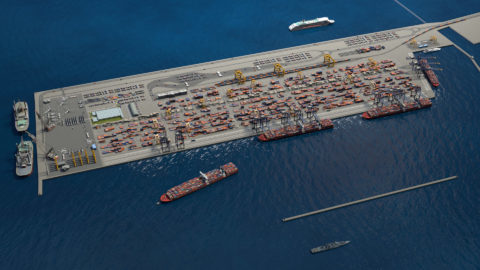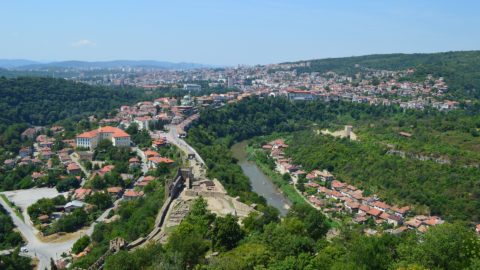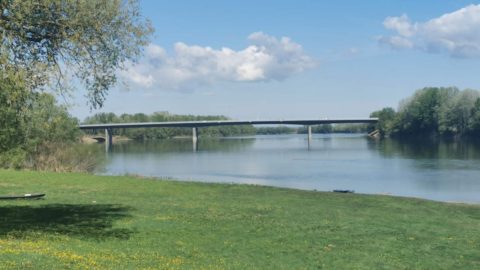Albania
From the geographic point of view, goods from Albania can be transported relatively quickly to the neighbouring countries: Macedonia, Montenegro, Bosnia and Herzegovina, and Kosovo. This is possible thanks to the A1 and A 2 motorways, which are part of the TEN-T network. A2 is part of the Albania-North corridor, which is connected with the Greek border. The potential of maritime transport is also interesting. Albania has 322 kilometres of coastline and four major ports: Durrës, Wlora, Saranda and Shëngjin. The port of Durrës is the country’s largest port. Its location is very favourable. Almost 78% of goods and passengers pass through this port. Rail transport comprises over 400 kilometres of main lines and over 200 kilometres of secondary lines. The network extends in various directions: north, south, and east to Macedonia and Tirana.
The Albanian government has developed adequate regulations for the development of intermodal transport, including the “Strategy for Transport 2010-2020”, which sets out concrete projects to be implemented. The strategic objective is to develop multimodal transport in Albania by connecting the Albanian ports of Durrës and Wlora with neighbouring countries, in particular within the Corridor 8, road A2, and a connection to Kosovo.
Bosnia and Herzegovina
Bosnia and Herzegovina is an important country in Central and Eastern Europe as far as transportation is concerned. The Pan-European 5C Corridor runs from Hungary towards Croatia, Bosnia and Herzegovina to the Adriatic Sea. The longest part of the route is in Bosnia and Herzegovina. There are also several important rail, passenger and freight connections. The country is home to four international airports: Sarajevo, Tuzla, Banja Luka and Mostar. Bosnia and Herzegovina also has access to the Adriatic Sea (24 kilometres of coastline). The favourable location of the Neum seaport (the only seaport in the country) makes it possible to use it for inland waterway transport as well. The port is planned to be expanded.
Bosnia and Herzegovina’s objective over the next 10-15 years is to develop the Corridor 5C, which will connect Hungary via Croatia and Bosnia and Herzegovina to the port of Neum. In addition, Bosnia and Herzegovina supports the implementation of the Via Carpatia project. Although the country is not directly connected to this route, but there exists a connection from Bosnia to Serbia, which in turn has a connection to Via Carpatia. Therefore, the project constitutes an important addition to the country’s international transport network.
Croatia
Croatia is located on a transport route along the continental corridor of the TEN-T European transport network with direct access to the European single market. Maritime transport has a key role for the country. The largest port in Rijeka is a transit port for neighbouring countries (for instance Hungary). It also benefits from the TEN-T corridor. The port’s goal is to increase its competitiveness so that it can offer services to neighbouring countries. To this end, the “Rijeka Gateway Program” is being implemented with the task to provide port and road infrastructure in the Rijeka port.
The port is located not only on the Mediterranean corridor, but also on the Adriatic-Baltic Sea corridor, which is why it is included in the “Belt and Road” initiative. Efforts are also being made to modernise railway connections between Rijeka and the Slovenian cities in order to provide a more efficient container transport service. In addition, multimodality is carried out by various means of transport, mostly involving roads (the motorway system in Croatia is very well developed). Currently more than 1/3 of the railway infrastructure’s potential is made use of, with significant growth recorded in recent years. Via various railway connections, the goods from the port of Rijeka reach Austria and Germany through Zagreb and Budapest.
The seaport system is complemented by the port of Ploče, which is important for such countries as Bosnia and Herzegovina, Serbia, Hungary, Slovakia and Czech Republic. The port is connected to the 5C Corridor. Another port, Zadar, is the fourth freight port, offering the shortest connection from here to Italy and Croatia, of only 80 nautical miles.
Macedonia
Macedonia is a transit country. There are two Pan-European corridors running across its territory – corridor VIII and corridor X. As a landlocked country, Macedonia is currently implementing projects along the corridors and is improving the quality of its transport services, as well as the competitiveness of its transport networks. Improved infrastructure along corridors VIII and X is intended to create new transport connections to major trade centres in Central and Eastern Europe and Asia. This includes transport connections from the Adriatic Sea and the Ionian Sea up to the Black Sea.
Macedonia is currently focusing on the construction of new motorways, roads and new rail connections, as well as on the reconstruction and modernisation of existing infrastructure. Macedonia has no access to the sea, and the ports nearest to it are located in Greece. The Republic of Macedonia’s strategic objectives are therefore to ensure lacking rail connections in Corridor VIII, a priority for all Ionian and Adriatic Sea countries, as well as to develop relations with Asia.
Montenegro
The most significant infrastructure projects currently undergoing in Montenegro are the Bar-Boljare motorway section, an express road along the country’s coastline, and the reconstruction of the Ribnica-Bar railways. It is of great importance that these projects are in line with the plans, goals and objectives of the “16+1” mechanism and the “Belt and Road” initiative. Montenegro is interested in the possibility of extending roads that would connect the country to the Via Carpatia route.
Montenegro also has a sea port at the city of Bar, which is located right at the Adriatic coast. The Bar harbour can serve as a starting point for transport projects planned under the “Belt and Route” initiative. In addition, Montenegro supports the main objective of the initiative – to involve China, the EU and the countries of Central Asia, East Africa, Middle East and Central and Eastern Europe in infrastructure, economic and trade projects.
Serbia
Due to Serbia’s geographical location, the Pan-European Mediterranean Corridor and the Rhine-Danube Corridor run across this country. Serbia’s main transport objective is to modernise, rebuild and construct new facilities along the main European transport corridors. Corridor X, which runs from Serbia’s north-western border with Hungary to the southeast, to the border with Macedonia, will become operational in the first half of 2018. On the other hand, the motorway from Belgrade to Montenegro is being built in cooperation with partners from Azerbaijan and China, with the involvement of local subcontractors. In addition, Corridor X is undergoing modernisation and reconstruction mainly with the aid of EU and other international funds. A new element in the reconstruction of railways is the financing and involvement of counterparts from Russia and China at the section running from Belgrade to Hungary.
The development of intermodal transport contributes significantly to the development of the railway network. Therefore, the activities of the Republic of Serbia are aimed at the development of intermodal transport, and the construction of a modern infrastructure of intermodal terminals. As a result, there are plans to build terminals in Belgrade and in Novi Sad.
Serbia sees the Belt and Route initiative as an opportunity to link European projects and the TEN-T network. Moreover, the Serbian government emphasizes that improvements in the communication infrastructure have undoubtedly contributed not only to attracting foreign investment, but also to the efficiency of the economy. The total value of all infrastructure projects in Serbia amounts to about 14.7 billion euro. Some projects are still ongoing, and others will be implemented in the near future. The completion of road, rail, water and air transport projects will be a confirmation that Serbia has fulfilled its mission and has become an integral part of Europe.
Slovenia
Two main transport corridors cross the territory of Slovenia: the Baltic-Adriatic corridor and the Mediterranean corridor. The country has a well-developed transport infrastructure and important transport hubs, as well as logistics centres in Ljubljana, Maribor and in the port of Koper. The motorway network is 700 km long and one of the densest in Europe. Slovenia has a railway network of over 1000 km and three international airports in Ljubljana, Maribor and Portorož. The infrastructure ensures the multimodality of all Slovenian transport corridors.
Maritime transport is an important element of the country’s transport system. The port of Koper is growing steadily, and it successfully maintains its leading position in the transportation of containers and vehicles along the northern Adriatic coast. The investments made in recent years have been aimed at the modernisation of the port infrastructure, and the deepening of the shipping waterways has already enabled transhipment carried out by 20 000 TEU vessels. Container transport is expected to grow, and a total transhipment of 24 million tonnes will be achieved and exceeded by the year 2020 and up to 35 million tonnes by the year 2030. Moreover, 60% of all goods are transported from the port by rail. This percentage is supposed to be further increased due to the construction of a second railway line on the Divača–Koper railway.
Slovenia also supports digitisation of the transportation and logistics sector, which will contribute to the reduction of administrative burdens and costs. There is also a plan to build a second railway line from the port in Koper to neighbouring countries, which should increase its throughput capacity.




 Albania
Albania Bosnia and
Bosnia and Bulgaria
Bulgaria China
China Croatia
Croatia Czechia
Czechia Estonia
Estonia Hungary
Hungary Latvia
Latvia Lithuania
Lithuania
 Montenegro
Montenegro Poland
Poland Romania
Romania Serbia
Serbia Slovakia
Slovakia Slovenia
Slovenia